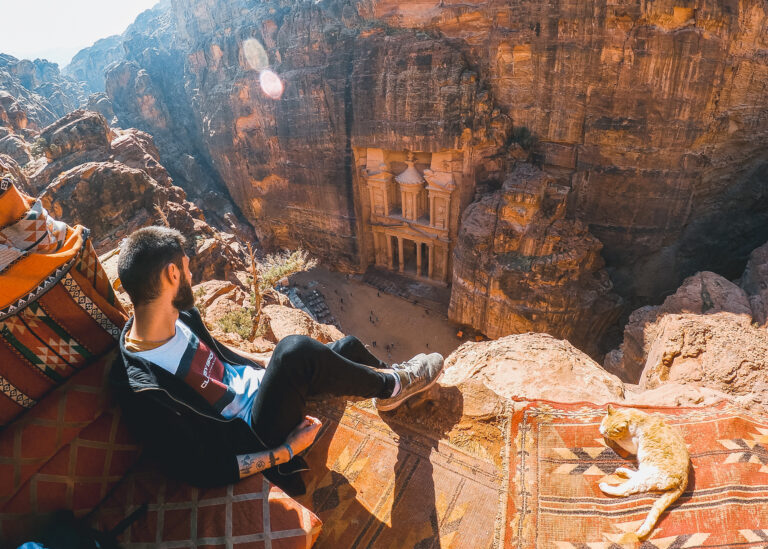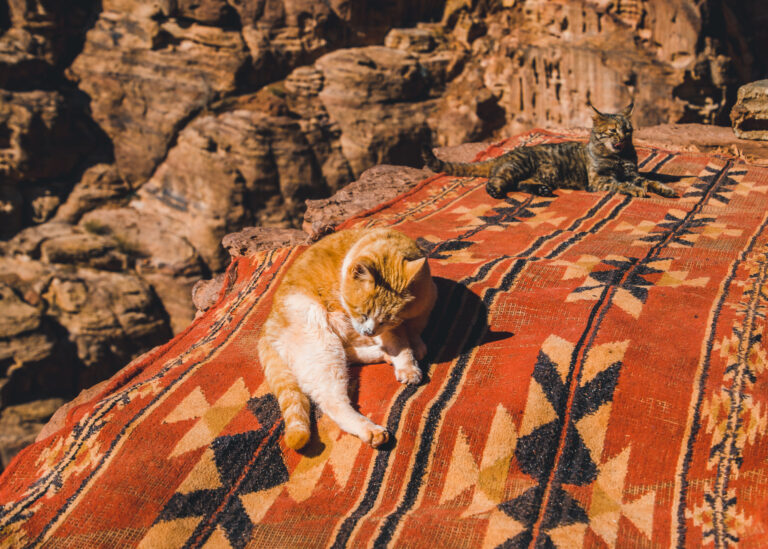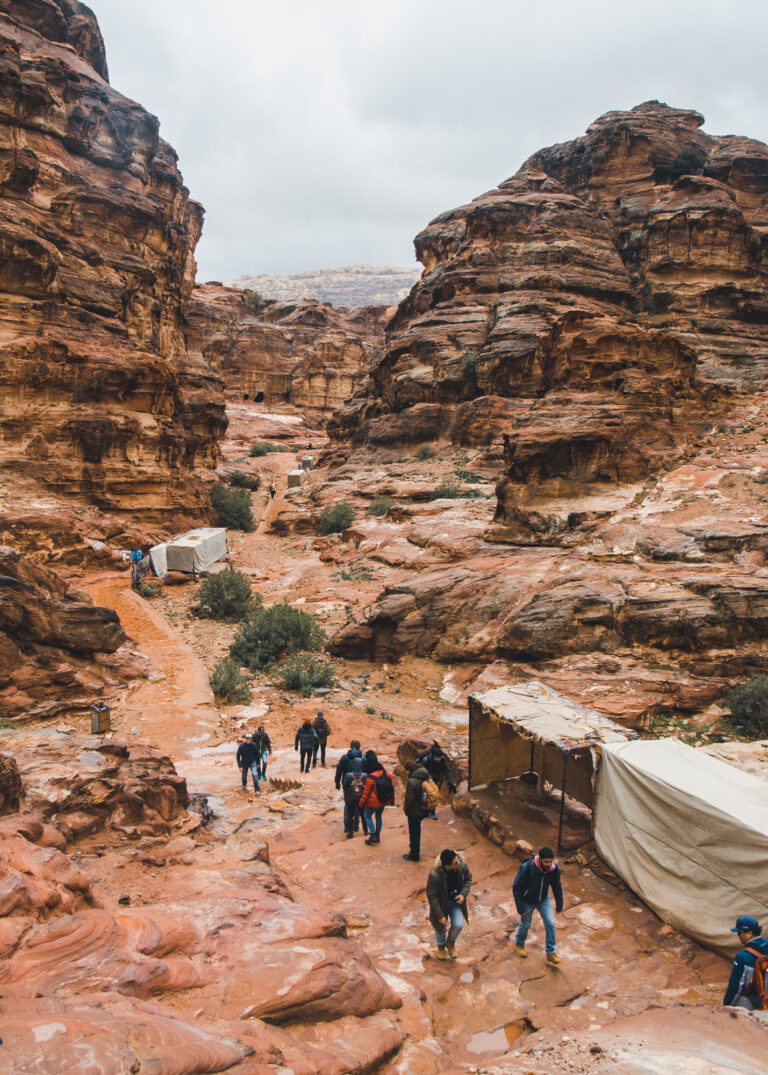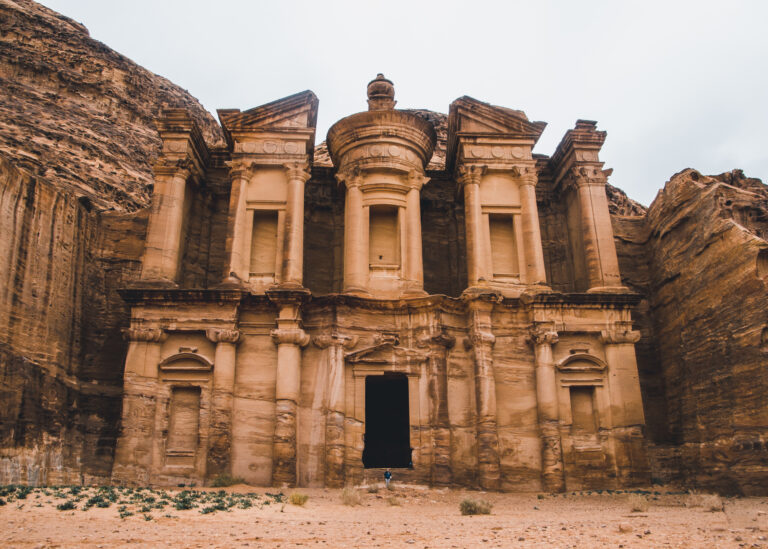Disclosure: This post contains affiliate links that I may earn a small commission from if you purchase something through them. This comes at no extra cost to you!
Forgotten for hundreds of years, the red fortress city of Petra (also called The Rose City or The Lost City) is the most anticipated stop of most traveller’s itineraries in Jordan, and it certainly was for me!
This extraordinary rock-carved city is one of the New7 Wonders of the World and a UNESCO World Heritage site. It is one of the most unique and gob-smacking man-made locations on the planet and undoubtedly an essential destination on any Jordan itinerary.
Covering a whopping 60 km², the mysterious desert landscape is located in southern Jordan, 3 hours south of its capital city Amman, and it is loaded with the ancient cave-homes, tombs and canyons where the Nabatean people once resided some 2,000 years ago – and where some of them still do!
There’s a 3.4km trail winding through the landscape taking visitors from the most famous stop, The Treasury, to the mighty Monastery which is situated on top of a hill at the highest point in the area. It’s truly amazing that a city thrived for so long in such a harsh environment, and to unlock all of the secrets Petra has in store you’ll really want at least two days to explore it all. Trust me, you won’t regret it!
In this guide I’ll provide all the information you need, including a bit of history, FAQs, photography, top tips and thoughts from my experience.
Table of Contents...
Toggle
Useful information for Petra
- Country: Jordan
- Language: Arabic
- Population: At its peak about 20,000 people lived in Petra. About 7,000 people live in the town of Wadi Musa today.
- Currency: 1 Jordanian Dinar (JOD) = £1.16/$1.40
- Visa info: Visitors from most nations can acquire a 2 month visa on arrival for Jordan at any of its international borders. The price for a visa is about $60 to be paid in cash unless you have a Jordan Pass, in which case the cost is free. For more visa information, click here.
- Sim cards: I always recommend picking up a local SIM card if you’re staying in a new country for a while as it means you don’t have to rely on WiFi and you can take Ubers or Grabs. The best service provider to use in Jordan is Orange, or alternatively get an eSIM before you arrive online here.

Where is Petra
Petra is located in the south of Jordan, a country in the Middle East, beside the town of Wadi Musa. Wadi Musa is 235km from Amman and 125km from the city of Aqaba in the south.
Check out the location on the interactive map below
Getting there
- Rent a car
The most adventurous way to get around Jordan is to rent a car and drive yourself. This is a popular thing to do among travellers as the country is quite small, with most attractions separated only by sparse desert.
From experience, although a very safe country, I wouldn’t recommend driving in Amman as it can be quite hectic on the roads and people drive more aggressively than normal. I suggest renting your car from the airport whenever you are ready and heading south from there, avoiding the city.
I used RentalCarsCom to find a car and paid just £130 ($152) for 6 days. Find the perfect deal on RentalCarsCom here.
- Tourist buses
If you plan to visit Petra from Amman you can jump on a tourist bus and head to Wadi Musa. If you plan to continue south afterwards, you can also catch a bus to Wadi Rum from Wadi Musa. There are no direct bus links to Wadi Rum from the capital though.
A tourist bus to Wadi Musa from Amman with JETT costs about $26 USD.
- Group tour
Booking a small group tour to see Petra is another awesome way to not only comfortably get there, but also have the knowledge of a local guide throughout your trip.
Sure, you won’t get as long at every stop as you would by visiting independently, but it provides a decent alternative to driving yourself if you don’t feel confident enough on the roads.
Group tours are available from Wadi Musa but if you are planning to visit Petra from Amman or Aqaba an air conditioned minivan or bus will transport you from your origin.
Some of the best tours of Petra:

Getting around
Once you’re inside the Petra zone, walking is the best way to get around no matter whether you’re on a tour of visiting solo.
Taking it slow and walking through the canyons and admiring every small detail is amazing, and even on foot you can see the best of Petra in one full day.
I’ll never recommend the riding of camels or donkeys anywhere in the world, although this is frequently pushed upon you in Petra. These animals are malnourished and often abused and I strongly deter you from using this as a mode of transport. You can read more about this in the ‘My experience’ section of the post at the end.

Expected costs
The longer you stay in Petra, the better value you’ll get for your money.
A one-day ticket costs 50 JOD ($70) per person, a two-day ticket is 55 JOD and it’s just 60 JOD for three days. Seeing ‘Petra By Night‘ costs an additional 17 JOD (more on this later).
You can buy your tickets at the Petra Visitor Centre when you arrive but I recommend getting a Jordan Pass before you land in the country which includes your entrance ticket and so much more!
Why you need to get a Jordan Pass
Get a Jordan Pass before you arrive in Jordan – it’s a no-brainer!
Not only does a Jordan Pass include your entire visa cost, but it also includes over 40 attractions in the country and your entrance to Petra and Wadi Rum. You are pretty much guaranteed to save money by getting one, and almost every single visitor to the country does. I mean, you’ve pretty much paid it off before you’ve even left the airport!
There are 3 types of Jordan Pass; Wanderer (70 JOD), Explorer (75 JOD) and Expert (80 JOD).
I went for the Jordan Explorer Pass as it includes 2 days in Petra for only 5 JOD more than the Wanderer Pass which only includes one, which is the only real difference between the three. The expert includes 3 days in Petra.
Here are some of the potential fees you will avoid with a Jordan Pass:
- Tourist visa on arrival: 60 JOD
- Petra (2 days): 55 JOD
- Wadi Rum: 5 JOD
- Jerash Ancient City: 10 JOD
- Madaba Archeological Park: 3 JOD
- Karak Castle: 2 JOD
- Jordan Museum: 5 JOD
- Amman Citadel: 2 JOD
- Amman Amphitheatre: 2 JOD
As you can see, you will definitely save money during your trip with one of these! To learn more about the Jordan Pass, follow this link to the official website.

When to visit
The best time to visit Petra is during Jordan’s cooler spring (March to May) or autumn months (September to November) as temperatures remain relatively high throughout day and night and there will be less tour groups around. That said, if you can handle the summer heat or the freezing winter, you’ll likely have the incredible Lost City all to yourself.
I visited in early January and felt like I was the only person there at many moments which was really special. Sure, it was super cold (as you can probably see from how wrapped up I am in all my pictures!) but it was so damn worth it.
A detailed history of Petra
The history of Petra is both mind-blowing and fascinating, so forgive me if I talk too much here – I love it!
Petra dates back around 2,300 years to 300 BC and was established by the Nabatean people, an Arab tribe of Bedouin roamers that still exist across the country today.
Apart from the natural wonder of the Siq (the natural road/canyon to enter the city) everything in the city was carved and chiselled by hand into towering rock faces before being painted in bright colours. The Nabateans carved intricate buildings, staircases, columns and statues from the sandstone rock. Soon, Petra became an important trading point for goods across Arabia and Asia where the Nabateans would offer shelter and water for traders in exchange for a fee.
Situated in such a harsh, rugged and dry landscape, it was only due to the innovation used in creating the water system that made Petra inhabitable for the Nabateans. They created dams to catch rainwater and cisterns to distribute it around the area during the dry season. Some of these 2,000 year old water systems are still used today for thirsty camels and
In the year 106AD the Romans invaded the then thriving trading city of Petra and won, claiming the city as their own for 250 years. The Byzantines (a different type of Roman) then took control for the next 300 years and fast-forward to the end of the 8th century and Petra was left empty and abandoned.
In 1812, after hearing rumours of this distant rock-cut city, a Swiss explorer named Johann Ludwig Burckhardt rediscovered Petra while disguised as an Arab traveler. Until this time it was a mysterious place that many people believed to be a legend and not to actually exist, but Burckhardt sneaked in ‘to sacrifice a goat’ and reported back to the world what he found.
In 1985, Petra was named a UNESCO World Heritage Site and in 2007 it was named a New7 Wonder of the World.
It continues to be one of the most historic and notable man-made destinations on Earth.

8 quick-fire Petra travel tips
1. Petra opening times
The Petra Visitor Centre is open from 6am to 6pm in summer and 6am to 4pm in winter. You’ll need to vacate the site by 7pm in summer and 5pm in winter unless you have a ticket to see Petra By Night.
Staying overnight in the Petra zone is not permitted.
2. How long to stay
I highly recommend planning to spend 2 days exploring Petra as a minimum.
There’s so much to see and you definitely won’t regret having extra time, even if you think you’ve completed it all on the first day. The price only changes by 5 JOD and you can use the second day to travel deeper into the nooks and crannies of the many caves, rock-carved alleyways and tombs.
3. Do you need a guide?
In short, no.
Don’t get me wrong, guides are great. But in Petra you’ll want to explore under your own steam and not feel rushed at any point which often happens when guides show you around. Simply by waking up early, grabbing a map from the Visitor Centre and having a sense of adventure you can see and learn all the secrets of Petra on your own.
If you’d like to have a guide, they can be arranged for around 50 JD from the Visitor Centre on arrival. Alternatively, browse online tours of Petra here if you’re interested.

4. Wear sturdy shoes
You’ll be on your feet all day doing some light hiking in rocky and sandy conditions so make sure you pack some comfortable and decent footwear for protection.
5. Are there shops inside?
Well, depending on your definition of shop, yes!
Throughout Petra you’ll find little tent-stalls selling things like water, souvenirs, tea, scarves and jewellery, but expect prices to be hugely inflated as it’s a tourist hot-spot. Best take plenty of water with you beforehand and use these stalls in emergencies.

6. Horse rides are ‘included’ but not recommended
7. The toilet situation
There are toilets dotted around Petra at various locations, but they aren’t all that common. Grab a map from the Visitor Centre and you’ll find them all listed on there.
8. See 'Petra By Night'
On Mondays, Wednesdays and Thursdays from 8:30pm to 10:30pm there are sound and light shows that emphasise Petra’s beauty in a whole new light… literally!
For just 17 JOD you can follow the 1500 candles lighting the way from the Siq to the Treasury and admire the peaceful scene under the stars. This is an experience I really wish I did while in Jordan, but I guess I’ll have to wait until next time!
The best 8 sights in Petra
In short, the best route to see the best sights of Petra is to venture from the Visitor Centre all the way up to the Monastery. This is easily in excess of 20,000 steps and about 6km one-way, so prepare to do a lot of walking while you explore the ancient city!
Before you validate your Jordan Pass in the Visitor Centre, be sure to check out the Petra Museum for free to briefly learn more about the amazing archeological zone before you enter.
From the Visitor Centre to the start of the Siq trail is about a 1.5km walk along a flat and simple dirt road.

1. The Siq
The Siq is where the adventure properly begins.
Walking through this large, narrow, naturally formed gorge for approximately 1.2km as it winds its way below towering sandstone cliffs sets the tone perfectly for the rest of the day.


In parts this magical entrance to Petra measures just 3 meters wide and reaches up to 80 meters tall, so it sure makes you feel tiny!
Eventually, after about 10 minutes, you will catch your first glimpse of the mighty Treasury.

2. The Treasury (Al Khazna)
The best preserved and most famous carving in Petra is the 130ft sandstone rock face of the Treasury.
This imposing architectural masterpiece measures 40m high and 25m wide and really takes your breath away. An exact date for when the Treasury was carved is unknown, but it is thought to of been around 9 BC – 40 AD, so about 2,000 years ago.
Likely because it is the first thing you come clasp your eyes on in Petra, it is notoriously the busiest place in the city (not to mention due to the part it played in a certain Indiana Jones movie) so prepare for noise and crowds here.

Peering inside the mausoleum you’ll notice that it’s large, inaccessible room is completely empty and it’s function has remained a mystery for generations. Although you cannot enter the room, marveling at this phenomenon from outside is certainly satisfying enough.
Facing the Treasury, turn right and scramble up the side of the hill to a small cliff edge so you are about 20m above the crowds. Here, there is an amazing viewpoint that provides a slightly elevated perspective and, unless it’s been raining, should be easily accessible.

We’ll hike to another amazing viewpoint looking down onto the Treasury later in this guide, so stay tuned for that!


3. The Petra Theatre
Continuing past the Treasury you’ll find a large, ancient auditorium carved into the side of the mountain which was built around the year 20 AD.
It has been majorly eroded over time by wind, rain and sand, but the Petra Theatre is still a mighty creation that could fit around 8,000 spectators in its prime. It would be used for performances and entertainment for the Nabatean rulers.


3. The Four Royal Tombs

3a) Urn Tomb
Of all four of the Royal Tombs, the elevated 26m face and epic four pillars of Urn Tomb is is the one where you’ll likely spend most of your time.
It requires a short set of stairs to reach and is believed to have been the tomb of Nabatean king Malchus II before being converted to a church around the year 450 AD.
You can enter the main room of Urn Tomb to admire its immense size and then get an epic view over the centre of Petra from the courtyard outside.



3b) Silk Tomb
3c) Corinthian Tomb
After Silk Tomb is Corinthian Tomb which is inaccessible and treated as more of a “view-while-walking-past” type of location, similar to Silk Tomb.
Although a masterpiece in its own right that dates back to around 40 -70 AD, its appearance is very faded and is somewhat outshined by its neighbours.
3d) Palace Tomb

4. Al-Khubtha Trail (Treasury viewpoint)
One of the Lost City’s hidden gems, hiking up the Al-Khubtha trail is one of the best off-the-beaten-path things to do here and takes you to somewhere that doesn’t see hundreds of tourists every day, despite offering a massive reward for your short journey.
For a superb view of the Treasury, the path starts by the Royal Tombs here and will take you up a long rocky staircase to a plateau, about 1.4km from the Corinthian Tomb in total. From the base of the Treasury the walk is about 3.5km to the viewpoint, passing the tombs and Nabatean Amphitheater on the way.
Follow the path and you’ll eventually get to the edge of the cliff face with a private and uninterrupted view of The Treasury from above.

There is a Bedouin man who lives up here with his cats and although there is no ticket fee for the view from his house, he will politely request that you purchase some tea or a cold drink from the coolbox instead. 2 JOD is a small price to pay for such a magical vista! Plus, you’ll likely be thirsty and want to relax after all the steps to get up here anyway.
There are no railings at the top so you need to take caution when standing or dangling your feet over the edge, but other than that there are no other particular things to know for this hidden gem.
Take your time soaking it up, meet the local cats and enjoy the view!




5. The Monastery (Ad Deir)
Around 800 rock-carved steps lead the ascent to the magnificent Monastery, with a distance of 3.4km between it and the Treasury.
The 1 hour walk from the Treasury takes you through the historic centre of the ancient city, past everything in this itinerary, before ascending up the huge plateau where you’ll find Ad Deir (the Monastery), which is the final attraction of Petra.
Marvel at the grand sandstone canyons and make sure you stop to look around on the way up!


Measuring 48m x 48m, Ad Deir is arguably the most epic carving in the whole of Petra and it was certainly my favourite location.
So many people don’t bother venturing this far for whatever reason, meaning you can take as many uninterrupted photos as you want. I spent around an hour here finding different angles and making the most of having it more or less empty.


There is a path leading away from the Monastery to the “best view in the world” which is a bold statement but a spot that should be witnessed nevertheless. It offers panoramic views over the surrounding hills and valleys.
Don’t miss the small caves and vantage points to look back on the Monastery from on the way.





My experience at Petra
Visiting Petra is one of the best travel experiences I’ve ever had.
I stayed in Wadi Musa for 3 nights and spent 2 full days in the ancient city and every single second I found myself in awe. I had high expectations and I’m glad to confirm that they were smashed out of the park!
I visited in January so I was fortunate enough to have the place almost completely empty. At times it felt like I was the only one there! That did mean that it was perilously cold though, but that was a price I was willing to pay.
Over two days I spent 10 hours inside Petra, walking 24km and climbing over 100 floors. Safe to say, I milked every second of it!
I reckon that one full day would definitely be enough time to see everything Petra has to offer for most people. That said, it’s a calming feeling having the second day option in case of bad weather or if you want to revisit anything, like I did. It only costs 5 JOD more… so why not?!
Overall, Petra is magnificent and if you have the time you’ll definitely not regret coming for 2 days.
On a more gloomy note, I did find it quite sad to see all the camels, donkeys and horses not looking or acting very healthily. Personally, I think it’s okay that locals use animals to roam around Petra as they have done for thousands of years, but it makes me uncomfortable seeing small donkeys and severely malnourished camels being physically abused and used purely to chauffeur large and sometimes overweight tourists around. I saw men hitting the animals and the camels in particular were visibly mistreated, under fed and thirsty.
So, yes, I saw locals treating the animals quite harshly here and couldn’t help but cringe, but I made sure these actions didn’t affect my overall opinion of this beautiful country.


Where to stay in Wadi Musa
Wadi Musa is the entry and exit point for Petra and is really the only option on where to base yourself. From the centre of town you can walk to the Petra Visitor or jump in a brief taxi to get there, but it is less than 1km in distance.
There are lots of accommodation options in town to suit all budgets.
The best rated hostel on Booking.com for proximity to Petra is Petra Cabin Hostel, which is right beside its entrance and has restaurants nearby. The best rated hostel to be closer to town is Rafiki Hostel.
Find somewhere you like on Booking.com or Hostelworld.
Best tours of Petra

Thank you for reading this travel guide – I hope you found it helpful! Feel free to leave a comment below if you have any questions and I’ll get back to you as soon as possible
Happy travelling!
HELPFUL RESOURCES FOR PLANNING YOUR TRIP
Accommodation: Booking.com, Hostelworld
Tours: GetYourGuide, Viator, Klook, TripAdvisor
Transport: 12Go, Omio, Trip.com, Rome2Rio
WHO IN THE WORLD IS JAMES?
Click below to learn more about my story, including 5 random facts about me, some travel FAQ’s and my entire travel history.


